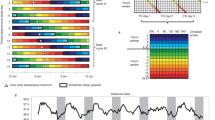Abstract
It is common knowledge that our feelings of alertness or drowsiness vary throughout the day. Indeed, this diurnal variation is so widely accepted that it has been used to validate the drowsy/alert component of activation obtained from mood adjective checklists1. There is, however, some evidence from sleep deprivation2 and shiftwork3 studies that this variation is not simply a reflection of our sleep/wake cycle, as might be expected, but is at least partially dependent on an endogenous circadian ( ∼ 24 h) oscillator such as that proposed to account for the circadian rhythm in body temperature and other physiological variables. Here we have tested this suggestion by separating the body-temperature rhythm from the sleep/wake cycle by progressively shortening artificial time cues (zeitgebers)4. Our results indicate that the circadian rhythm in alertness can become independent of both the sleep/wake cycle and the rhythm in body temperature. Further, and contrary to our expectations, the results suggest that the sleep/wake cycle exerts less influence on the alertness rhythm than it does on that of temperature.
Similar content being viewed by others
References
Thayer, R. E. Motivation Emotion 2, 1–34 (1978).
Froberg, J. E. Biol. Psychol. 5, 119–134 (1977).
Folkard, S., Monk, T. H. & Lobban, M. C. Ergonomics 21, 785–799 (1978).
Folkard, S., Minors, D. S. & Waterhouse, J. M. J. Physiol., Lond. 357, 341–356 (1984).
Wever, R. A. The Circadian System of Man: Results of Experiments under Temporal Isolation (Springer, New York, 1979).
Kronauer, R. E., Czeisler, C. A., Pilato, S. F., Moore-Ede, M. C. & Weitzman, E. D. Am. J. Physiol. 242, R3–R17 (1982).
Borbely, A. A. Hum. Neurobiol. 1, 195–204 (1982).
Czeisler, C. A., Weitzman, E. D., Moore-Ede, M. C., Zimmerman, J. C. & Knauer, R. S. Science 210, 1264–1267 (1980).
Winfree, A. T. Nature 297, 23–27 (1982).
Minors, D. S. & Waterhouse, J. M. Circadian Rhythms and the Human (Wright P. S. G., Bristol, 1981).
Wever, R. A. Pflügers Arch. ges. Physiol. 396, 128–137 (1983).
Folkard, S., Wever, R. A. & Wildgruber, Ch. M. Nature 305, 223–226 (1983).
Elliot, A. L., Mills, J. N., Minors, D. S. & Waterhouse, J. M. J. Physiol., Lond. 221, 227–257 (1972).
Halberg, E. et al. Chronobiologia 8, 253–271 (1981).
Monk, T. H. & Fort, A. Int. J. Chronobiol. 8, 193–224 (1983).
Monk, T. H., Leng, V. C., Folkard, S. & Weitzman, E. D. Chronobiologia 10, 49–55 (1982).
Wever, R. A. J. Interdiscipl. Cycle Res. 3, 253–265 (1972).
Hughes, D. G. & Folkard, S. Nature 264, 232–234 (1976).
Author information
Authors and Affiliations
Rights and permissions
About this article
Cite this article
Folkard, S., Hume, K., Minors, D. et al. Independence of the circadian rhythm in alertness from the sleep/wake cycle. Nature 313, 678–679 (1985). https://doi.org/10.1038/313678a0
Received:
Accepted:
Issue Date:
DOI: https://doi.org/10.1038/313678a0
- Springer Nature Limited
This article is cited by
-
Quo Vadis, Chronopsychology?
Neuroscience and Behavioral Physiology (2021)
-
Effects of light treatment on sleep structure in seasonal affective disorder
European Archives of Psychiatry and Clinical Neuroscience (1993)
-
Biological aspects and self-evaluation of shiftwork adaptation
International Archives of Occupational and Environmental Health (1989)





